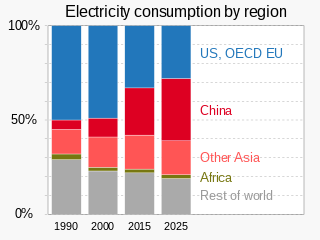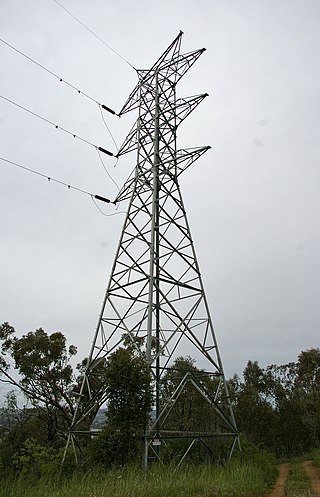Green electricity in Australia is available from a number of utilities that supply electricity from environmentally friendly energy sources that are renewable and non-polluting. In Australia green energy is accredited under the GreenPower scheme whereby all distributors are government audited bi-annually to ensure that customers are getting exactly what is described in their purchased products. The growth and development of the green energy industry was tracked in Australia by the ALTEX-Australia alternative energy index from 2006 to 2011.
In the 2009 settlement period there were 904,716 GreenPower customers Australia-wide, accounting for a total of 2,194,934 MWh of electricity generation, a 10% increase over 2008. This total electricity provision was divided between residential customers who purchased 1,001,195 MWh, and business customers who purchased 1,193,739 MWh. [1] [2] By the 2014 settlement period the number of GreenPower customers Australia-wide was at 497,406, and total purchases accounted for 1,279,281 MWh. [3]
The largest nationwide distributors were EnergyAustralia, Origin Energy, and TRUenergy. As of 2008 these companies offered a residential GreenPower accredited program:
The Renewables Obligation (RO) is designed to encourage generation of electricity from eligible renewable sources in the United Kingdom. It was introduced in England and Wales and in a different form in Scotland in April 2002 and in Northern Ireland in April 2005, replacing the Non-Fossil Fuel Obligation which operated from 1990.
The National Electricity Market (NEM) is an arrangement in Australia's electricity sector for the connection of the electricity transmission grids of the eastern and southern Australia states and territories to create a cross-state wholesale electricity market. The Australian Energy Market Commission develops and maintains the Australian National Electricity Rules (NER), which have the force of law in the states and territories participating in NEM. The Rules are enforced by the Australian Energy Regulator. The day-to-day management of NEM is performed by the Australian Energy Market Operator.
Renewable Energy Certificates (RECs), also known as Green tags, Renewable Energy Credits, Renewable Electricity Certificates, or Tradable Renewable Certificates (TRCs), are tradable, non-tangible energy certificates in the United States that represent proof that 1 megawatt-hour (MWh) of electricity was generated from an eligible renewable energy resource and was fed into the shared system of power lines which transport energy. Solar renewable energy certificates (SRECs) are RECs that are specifically generated by solar energy.

EnergyAustralia was a state–owned enterprise of the Government of New South Wales, Australia. It was electricity and gas supplier and retailer which primarily supplied the Sydney, Newcastle and Central Coast areas of New South Wales. Since market deregulation, it increased its focus on retail supply opportunities in electricity and gas to the Victorian market and electricity in the deregulated south–east corner of Queensland.
EnergyAustralia is an electricity generation, electricity and gas retailing private company in Australia. It is one of the "big three" retailers in the National Electricity Market. It generates electricity primarily using coal fired generation, at the Yallourn Power Station in Victoria, and the Mount Piper Power Station in New South Wales. 10% of its generation is from wind power, 32% from gas, and 58% from coal. It is Australia's second biggest emitter of greenhouse gases, after AGL Energy. As a loss making company in 2023, its parent in Hong Kong, CLP Group, has stated that it is looking for partners for renewable energy investment, however as of this time, there were no plans to build new renewable energy itself.

Origin Energy Ltd is an ASX listed public company with headquarters in Sydney. It is a major integrated electricity generator, and electricity and natural gas retailer. It operates Eraring Power Station, Australia’s largest coal-fired power station, in New South Wales, which it plans to close in 2025. In 2022, it was Australia's fourth largest climate polluter. It owns 20% of Octopus Energy, a UK renewable energy retailer, a stake potentially worth billions of dollars.

Synergy is a corporation owned by the Government of Western Australia. Synergy is Western Australia’s largest energy retailer and generator with more than one million industrial, commercial and residential customers, generating total annual revenue of more than $3.2 billion.

Electric energy consumption is energy consumption in the form of electrical energy. About a fifth of global energy is consumed as electricity: for residential, industrial, commercial, transportation and other purposes. Quickly increasing this share by further electrification is extremely important to limit climate change, because most other energy is consumed by burning fossil fuels thus emitting greenhouse gases which trap heat.

Solar power is a major contributor to electricity supply in Australia. As of December 2023, Australia's over 3.69 million solar PV installations had a combined capacity of 34.2 GW photovoltaic (PV) solar power. In 2019, 59 solar PV projects with a combined capacity of 2,881 MW were either under construction, constructed or due to start construction having reached financial closure. Solar accounted for 12.4% of Australia's total electrical energy production in 2021.

Renewable energy in Australia is mainly based on biomass, solar, wind, and hydro generation. Over a third of electricity is generated from renewables, and is increasing, with a target to phase out coal power before 2040. Wind energy and rooftop solar have particularly grown since 2010. The growth has been stimulated by government energy policy in order to limit the rate of climate change in Australia that has been brought about by the use of fossil fuels. Pros and cons of various types of renewable energy are being investigated, and more recently there have been trials of green hydrogen and wave power.
Financial incentives for photovoltaics are incentives offered to electricity consumers to install and operate solar-electric generating systems, also known as photovoltaics (PV).
A feed-in tariff is a policy mechanism designed to accelerate investment in renewable energy technologies by offering long-term contracts to renewable energy producers. This means promising renewable energy producers an above-market price and providing price certainty and long-term contracts that help finance renewable energy investments. Typically, FITs award different prices to different sources of renewable energy in order to encourage the development of one technology over another. For example, technologies such as wind power and solar PV are awarded a higher price per kWh than tidal power. FITs often include a "digression": a gradual decrease of the price or tariff in order to follow and encourage technological cost reductions.

The Electricity Commission of New South Wales, sometimes called Elcom, was a statutory authority responsible for electricity generation and its bulk transmission throughout New South Wales, Australia. The commission was established on 22 May 1950 by the Electricity Commission Act 1950 to take control of power generation in the State. The commission acquired the power stations and main transmission lines of the four major supply authorities: Southern Electricity Supply, Sydney County Council, the Department of Railways and the Electric Light and Power Supply Corporation Ltd, also known as the Balmain Electric Light Company, the owner and operator of Balmain Power Station. The commission was responsible for the centralised co-ordination of electricity generation and transmission in the State, and some local councils continued to be distributors of electricity only.

Feed-in tariffs in Australia are the feed-in tariffs (FITs) paid under various State schemes to non-commercial producers of electricity generated by solar photovoltaic (PV) systems using solar panels. They are a way of subsidising and encouraging uptake of renewable energy and in Australia have been enacted at the State level, in conjunction with a federal mandatory renewable energy target.

Solar hot water refers to water heated by solar energy, a renewable energy source derived from the sun. This process involves thermal collectors, often called solar panels, which absorb solar energy to increase the temperature of the water. The heated water is then stored in a reservoir tank for future use. Solar hot water systems are utilized for a variety of purposes, including domestic and commercial water heating, contributing to heating and cooling systems, and providing process heat for industrial applications.

Bullfrog Power, an Envest company, is a Canadian green energy retailer operating in Canada. Bullfrog offers green electricity from renewable energy sources such as wind, solar, and low-impact hydro, as well as green fuel and green natural gas, a renewable biogas product that serves as an alternative to fossil fuel-based natural gas. Bullfrog only sources electricity from generation sources that meet or exceed the federal government's Environmental Choice Program EcoLogo standard for renewable electricity. Bullfrog's green natural gas product is produced at facilities that have met environmental standards as defined by ICF International.
Ombudsmen in Australia are independent agencies who assist when a dispute arises between individuals and industry bodies or government agencies. Government ombudsman services are free to the public, like many other ombudsman and dispute resolution services, and are a means of resolving disputes outside of the court systems. Australia has an ombudsman assigned for each state; as well as an ombudsman for the Commonwealth of Australia. As laws differ between states just one process, or policy, cannot be used across the Commonwealth. All government bodies are within the jurisdiction of the ombudsman.

The electricity sector in Australia has been historically dominated by coal-fired power stations, but renewables are forming a rapidly growing fraction of supply. In 2021, Australia's electricity production reached 265 TWh, with coal accounting for 52.9% and natural gas for 18.8%. Renewable sources, comprising solar, wind, hydro, and bioenergy with waste, collectively made up 26.7% of the total electricity generation mix.
Neoen is a French producer of exclusively renewable energy headquartered in Paris, France. Founded in 2008, it develops, finances, builds and operates solar power plants, wind farms and energy storage solutions. As at 30 June 2023, the company's total capacity was 7 GW, made up of 47% solar, 34% wind and 19% battery storage. Neoen aims to attain 10 GW in operation or under construction by 2025.
Shell Energy Australia provides gas, electricity, environmental products and energy productivity services to commercial and industrial customers.